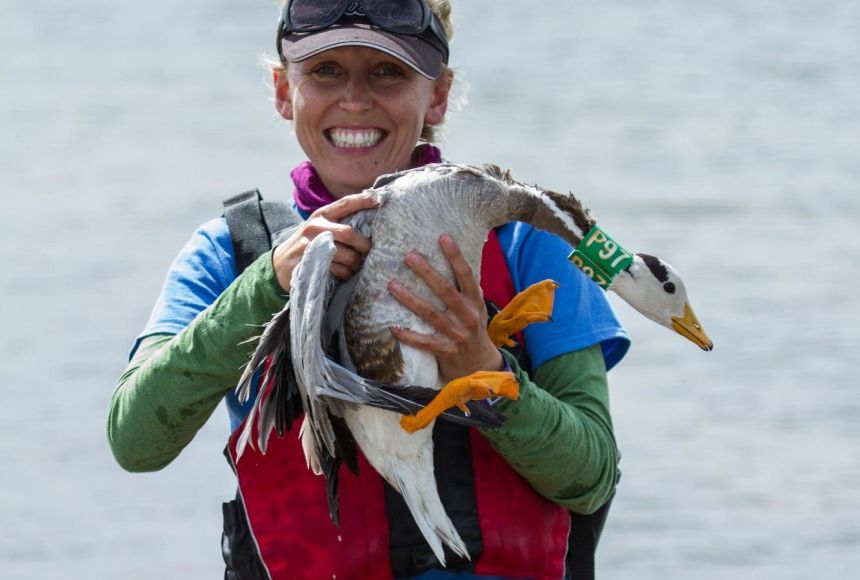Long distance runners dedicate weeks, even months, to building up their stamina and strength for races. Aspiring marathoners may spend half the year training, gradually building the strength and endurance necessary to run a 42.1-kilometer (26.2-mile) race.
Yet most migratory birds—like the godwits (Limosa lapponica) that make nonstop 11,000-kilometer (6,835-mile) flights or the arctic terns (Sterna paradisaea) that fly more than 70,000 kilometers (about 43,500 miles) annually—do not seem to train at all before completing their incredible voyages.
Lucy Alice Hawkes, a National Geographic Explorer grantee and a physiological ecologist, knows this firsthand. She studies the bar-headed goose (Anser indicus). This species has a tough migratory route, a 5,140-kilometer (3,194-mile) trip that can last over 90 days; one particularly grueling leg of the trip is a seven to 10 hour flight through the Himalayas at 6,000 meters (19,685 feet) above sea level. At this altitude, the air is so oxygen-poor that even walking can leave the fittest of human athletes breathless. The geese, however, make this trip without difficulty—and without training.
To Lucy, this extreme feat of avian athleticism is fascinating and mind-boggling. As a physiological ecologist, Lucy is driven to understand how an animal’s physiology, which includes its hormones, organs, muscles, and metabolic processes, provide the power and motivation for its migration. “[When] I look at animals migrating,” Lucy says, “I think: how can I find out how you do that?”
The making of a real-life animal detective
Lucy has long been fascinated with the natural world, especially the sea. Growing up on the coast in the United Kingdom, she spent her days scrambling around beaches, scuba diving, and peering into rock pools. Lucy did not consider herself destined for marine biology, however; she wanted to be a surgeon. Still, she could not escape her longtime passion for marine biology, and she ended up completing an undergraduate degree in the subject at Plymouth University.
After graduation, Lucy’s trajectory was more spontaneous than planned. “My whole life, [I’ve always] been very open to opportunity and very willing to put myself out there,” she explains, “It’s led to really cool adventures.” First, she became a volunteer at a sea turtle conservation group. Lucy excelled at her job and quickly became the organization’s project leader. During this time, she began studying the turtles’ migratory behavior, affixing miniature tracking devices to her study species. With encouragement from her colleagues, she expanded her tracking studies into a doctoral dissertation, which she successfully completed at the University of Exeter.
Lucy began branching out from marine life during her postdoctoral position at Bangor University, working with bar-headed geese. She and her colleagues outfitted geese with data loggers that recorded the birds’ physical activity, heart rate, and temperature in the weeks leading up to migration. The data from these loggers revealed the surprising finding that bar-headed geese do not appear to undertake any extra exercise leading up to migration; over those few weeks, the data showed no changes in maximum heart rate per day or minimum resting heart rate.
One of the coolest things about her work, she says, is knowing that she is helping to discover things that no one has known before. “I’m like a real life animal detective!” Lucy says. “When I was first tracking turtle migrations, we had no idea where those turtles went in the winter—and I got to be the very first person to ever find that out! [That’s such] a rare opportunity and such a cool thing.”
What is next for Lucy?
Lucy is currently a faculty member at the University of Exeter, and she continues to study movement and migratory behavior in a variety of organisms, including sharks, bluefin tuna (Thunnus thynnus), and stingrays (Myliobatoidei). She is also now collaborating with medical researchers on the physiology of high-altitude paragliders, who face the same environmental stressors as the geese. It is hard to say where her path will next take her, though—so far, she has worked in places as far-flung as Costa Rica, West Africa, India, and Mongolia. In each place she visits, she traps, tracks, and lovingly handles her study species. She has no plans to stop exploring the natural world. “We’re adventurous sorts, in general, field biologists,” Lucy says. “Sometimes you have to put yourself out there and see what happens.”
